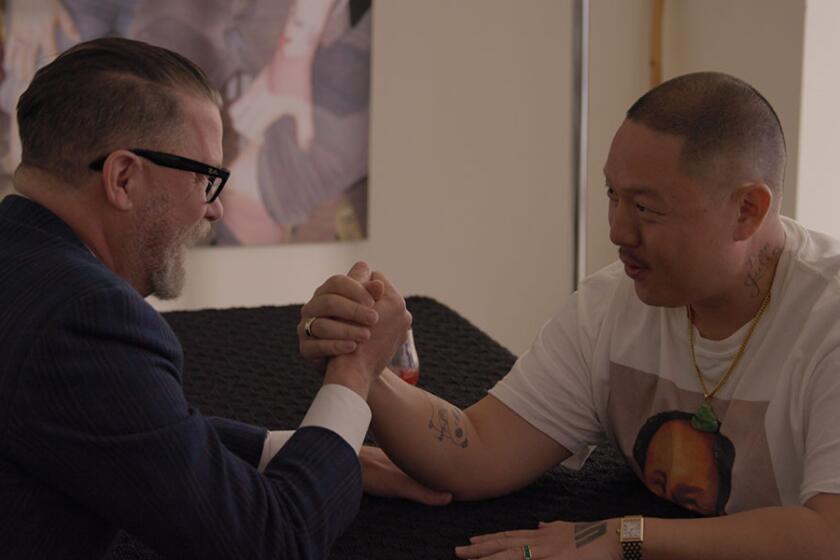Indie Focus: Andrea Arnold’s bold moves in ‘Wuthering Heights’
The frippery of period drama does not seem the natural province of English filmmaker Andrea Arnold. Her previous feature films, “Red Road” and “Fish Tank,” as well as her Oscar-winning short film “Wasp,” are all urban-set and ultra-contemporary, dealing with the problems of the here and now.
Yet her historical adaptation of Emily Brontë’s novel “Wuthering Heights,” opening in Los Angeles on Friday, feels both exactly of a piece with Arnold’s earlier work and also a bold step forward. The setting may be in the past, but the feelings are present-tense.
“Lots of people have said when they see it, ‘It feels like something of yours; it doesn’t feel like it’s not yours,’” Arnold said during a recent stopover in Los Angeles. A onetime actress and U.K. television presenter, Arnold, 51, eventually left TV to begin her career as a filmmaker, studying at the American Film Institute.
The remote hill farm in Yorkshire that served as the main location for her “Wuthering Heights” was evocative of the wind-swept romance and mud-caked brutality of the original story — also for those familiar with the atmospheric 1978 Kate Bush song based on the book — yet Arnold’s adaptation of “Wuthering Heights” does make two decisive, singularly striking moves.
First, she covers only the first half of the book, as a boy named Heathcliff is taken in by a family and falls in love with young Cathy. After his passion drives him away from the farm, he returns a few years later to win her back but finds she has since married. Their strong, unbreakable bond causes dire consequences for them both.
Then, citing descriptions of the character in the book, Arnold cast black actors in the role of Heathcliff, with Solomon Glave as young Heathcliff and James Howson as the slightly older version of the character. (Shannon Beer and Kaya Scodelario play the younger and older versions of Cathy, respectively.)
It took convincing for Arnold to make the film, even though she immediately saw the connection between Heathcliff’s struggles and those of characters in her contemporary films. A longtime fan of the book, she was reluctant to bring it once again to the screen — there have been some 15 versions for film and television.
“I’m not a fan of taking books and trying to turn them into films,” Arnold said. “Cinema is a completely different form, and if you’re going to do cinema, why not start with images in your head? Think cinema.
“And everyone comes with their idea of how the book is. You’re onto one big losing battle, aren’t you?”
But once on board, Arnold’s willingness to do something she thought might not work is indicative of the adventuresome, exploratory spirit that runs through all her films. Even her visual style, hand-held camera work captured within a boxy aspect ratio, gives them an unexpected jolt of immediacy.
“I think it’s a case of she knows what she doesn’t want, and knowing what she doesn’t want means cutting through all the other stuff to get to what you do want,” said cinematographer Robbie Ryan, who won a prize for his work on “Wuthering Heights” when it premiered at the 2011 Venice Film Festival and also worked with Arnold on her previous films.
“I think what she does like is chaos and spontaneity,” added Ryan, “a lot of things some people fear, she just loves to embrace.”
In one of the film’s most startling moments, Scodelario’s Cathy strikes herself hard in the chest as she argues with Howson’s Heathcliff, an unscripted action the actress says she doesn’t even remember doing. To heighten the actors’ emotional connection to the characters and each other, Arnold would sometimes have them shoot a scene saying their dialogue and then have them do it again silently, saying the lines only in their heads.
“Those moments of silence, those looks, those are the feelings,” Scodelario said of the film’s emotional vibrancy, “that’s where it comes out. She would just capture little moments, flickers in our eyes of what we were feeling. To me, every period drama has been very much explained, the characters tell you what’s going on in every situation, everyone walks very slowly and looks perfect and this was just completely different.”
Arnold is working on another script of her own, and though she prefers to keep the details to herself, she allows that it is again set in the contemporary world. She has turned down numerous offers to direct commercials, even though her expressive style seems tailor-made for the advertising world. This brings up why she creates cinema at all and what draws her to making movies in the first place.
Taking in a long breath, she simply exhales a long string of the phrase, “I don’t know,” before stopping on “I don’t think there’s an answer to that question.”
PHOTOS AND MORE:
PHOTOS: Hollywood back lot moments
Latest movie reviews
PHOTOS: NC-17 movies: Why they got the rating
More to Read
Only good movies
Get the Indie Focus newsletter, Mark Olsen's weekly guide to the world of cinema.
You may occasionally receive promotional content from the Los Angeles Times.











